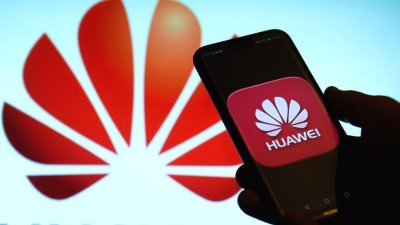Huawei's AI Power Play: New Infrastructure Challenges Nvidia's China Dominance
By: @devadigax

Huawei, the Chinese tech giant, has unveiled a significant advancement in its AI infrastructure, directly challenging Nvidia's dominance in the Chinese market. The announcement, shrouded in strategic importance given the ongoing geopolitical tensions, centers around Huawei's new SuperPoD interconnect technology. This technology allows for the creation of massive, high-performance computing clusters built from its own domestically produced AI chips, effectively circumventing reliance on foreign components, notably those from Nvidia.
This move represents a bold step towards self-reliance in a sector critical to China's technological aspirations. For years, Nvidia's GPUs have been the industry standard for AI development, powering everything from research labs to large-scale data centers. However, increasing US restrictions on the export of advanced semiconductor technology to China have created an opening for domestic players like Huawei to fill the void. SuperPoD aims to capitalize on this opportunity.
The core innovation lies in SuperPoD's ability to efficiently interconnect numerous AI processing units (APUs), dramatically increasing the overall computational power of the cluster. This is crucial for handling the massive datasets required for training advanced AI models. While specifics regarding the performance benchmarks of SuperPoD remain limited, industry analysts suggest it's a serious competitor to Nvidia's existing interconnect solutions, particularly in scenarios requiring high bandwidth and low latency.
The implications for the global AI landscape are substantial. China's ambition to become a world leader in artificial intelligence is well-documented, and Huawei's move signifies a concerted effort to achieve technological independence in this crucial field. By developing its own interconnect technology and leveraging its existing AI chip designs, Huawei is not simply replacing Nvidia's hardware; it's building an entire ecosystem designed to support China's AI ambitions without external reliance.
The development is also likely to intensify the already fraught geopolitical tensions between the US and China. The US government's restrictions on the export of advanced chips to China are aimed at curbing China's technological advancement and military capabilities. Huawei's successful development and deployment of SuperPoD, however, demonstrates a potent response to these restrictions, showcasing the resilience and adaptability of the Chinese tech sector.
Furthermore, the success of SuperPoD could potentially influence the strategies of other Chinese companies seeking to develop their own AI infrastructure. It offers a proven model for bypassing reliance on foreign technology, potentially leading to a more fragmented global AI market. This fragmentation could lead to the development of distinct AI ecosystems, with different standards and architectures, ultimately altering the dynamics of international collaboration in the field.
However, challenges remain. While SuperPoD represents a significant advancement, it's unclear whether it can entirely match the performance and ecosystem maturity of Nvidia's solutions in the short term. Nvidia's extensive software ecosystem and widespread adoption in the global AI community represent a significant advantage. Huawei will need to invest heavily in software development and community building to ensure its technology is widely adopted and supported.
The longer-term impact of Huawei's SuperPoD remains to be seen. Its success will depend on factors beyond technical specifications, including the availability of supporting software, developer community engagement, and the overall stability and scalability of the technology in large-scale deployments. Nevertheless, the announcement marks a crucial turning point in the global AI race, underscoring China's determination to establish technological self-reliance and challenging the long-held dominance of Western technology giants in this critical sector. The competitive landscape has shifted, and the future of AI infrastructure will likely be shaped by this ongoing technological rivalry.
This move represents a bold step towards self-reliance in a sector critical to China's technological aspirations. For years, Nvidia's GPUs have been the industry standard for AI development, powering everything from research labs to large-scale data centers. However, increasing US restrictions on the export of advanced semiconductor technology to China have created an opening for domestic players like Huawei to fill the void. SuperPoD aims to capitalize on this opportunity.
The core innovation lies in SuperPoD's ability to efficiently interconnect numerous AI processing units (APUs), dramatically increasing the overall computational power of the cluster. This is crucial for handling the massive datasets required for training advanced AI models. While specifics regarding the performance benchmarks of SuperPoD remain limited, industry analysts suggest it's a serious competitor to Nvidia's existing interconnect solutions, particularly in scenarios requiring high bandwidth and low latency.
The implications for the global AI landscape are substantial. China's ambition to become a world leader in artificial intelligence is well-documented, and Huawei's move signifies a concerted effort to achieve technological independence in this crucial field. By developing its own interconnect technology and leveraging its existing AI chip designs, Huawei is not simply replacing Nvidia's hardware; it's building an entire ecosystem designed to support China's AI ambitions without external reliance.
The development is also likely to intensify the already fraught geopolitical tensions between the US and China. The US government's restrictions on the export of advanced chips to China are aimed at curbing China's technological advancement and military capabilities. Huawei's successful development and deployment of SuperPoD, however, demonstrates a potent response to these restrictions, showcasing the resilience and adaptability of the Chinese tech sector.
Furthermore, the success of SuperPoD could potentially influence the strategies of other Chinese companies seeking to develop their own AI infrastructure. It offers a proven model for bypassing reliance on foreign technology, potentially leading to a more fragmented global AI market. This fragmentation could lead to the development of distinct AI ecosystems, with different standards and architectures, ultimately altering the dynamics of international collaboration in the field.
However, challenges remain. While SuperPoD represents a significant advancement, it's unclear whether it can entirely match the performance and ecosystem maturity of Nvidia's solutions in the short term. Nvidia's extensive software ecosystem and widespread adoption in the global AI community represent a significant advantage. Huawei will need to invest heavily in software development and community building to ensure its technology is widely adopted and supported.
The longer-term impact of Huawei's SuperPoD remains to be seen. Its success will depend on factors beyond technical specifications, including the availability of supporting software, developer community engagement, and the overall stability and scalability of the technology in large-scale deployments. Nevertheless, the announcement marks a crucial turning point in the global AI race, underscoring China's determination to establish technological self-reliance and challenging the long-held dominance of Western technology giants in this critical sector. The competitive landscape has shifted, and the future of AI infrastructure will likely be shaped by this ongoing technological rivalry.
Comments
Related News

OpenAI Unveils ChatGPT Atlas: Your Browser Just Became Your Smartest AI Assistant
In a move poised to fundamentally reshape how we interact with the internet, OpenAI has officially launched ChatGPT Atlas, a gr...
@devadigax | 22 Oct 2025
In a move poised to fundamentally reshape how we interact with the internet, OpenAI has officially launched ChatGPT Atlas, a gr...
@devadigax | 22 Oct 2025

Netflix Doubles Down on Generative AI, Challenging Hollywood's Divide Over Creative Futures
In a move that underscores a growing chasm within the entertainment industry, streaming giant Netflix is reportedly going "all ...
@devadigax | 21 Oct 2025
In a move that underscores a growing chasm within the entertainment industry, streaming giant Netflix is reportedly going "all ...
@devadigax | 21 Oct 2025

AI Agent Pioneer LangChain Achieves Unicorn Status with $1.25 Billion Valuation
LangChain, the innovative open-source framework at the forefront of building AI agents, has officially joined the exclusive clu...
@devadigax | 21 Oct 2025
LangChain, the innovative open-source framework at the forefront of building AI agents, has officially joined the exclusive clu...
@devadigax | 21 Oct 2025

Meta Boots ChatGPT From WhatsApp: A Strategic Play for AI Dominance and Walled Gardens
In a significant move that reshapes the landscape of AI chatbot accessibility, OpenAI has officially confirmed that its popular...
@devadigax | 21 Oct 2025
In a significant move that reshapes the landscape of AI chatbot accessibility, OpenAI has officially confirmed that its popular...
@devadigax | 21 Oct 2025

Meta's New AI Peeks Into Your Camera Roll: The 'Shareworthy' Feature Raises Privacy Eyebrows
Meta, the parent company of Facebook, has rolled out a new, somewhat controversial artificial intelligence feature to its users...
@devadigax | 18 Oct 2025
Meta, the parent company of Facebook, has rolled out a new, somewhat controversial artificial intelligence feature to its users...
@devadigax | 18 Oct 2025
 AI Tool Buzz
AI Tool Buzz